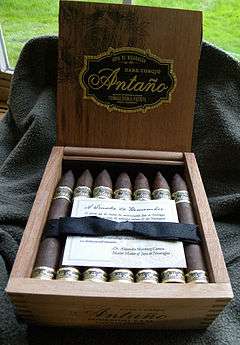Joya de Nicaragua
Joya de Nicaragua, S.A., established in 1968, is the oldest brand of cigars made in Nicaragua. The company continues to manufacture its products today from its headquarters in Estelí, today a major manufacturing center of handmade cigars with exports made worldwide.
Company history
Establishment

Cigar-making came to Nicaragua in the aftermath of the Cuban Revolution of 1959. In the years immediately following the overthrow of the regime of Fulgencio Batista by Fidel Castro, the export of raw tobacco and finished cigars from Cuba to the United States was initially permitted. This situation changed dramatically in 1962 when President John F. Kennedy imposed a stringent embargo against Cuba.
Owners of tobacco companies and leading growers had already fled the island in the aftermath of the revolution, with its nationalization of the cigar industry. New areas for the cultivation of cigar tobacco were explored. One of the most promising of these new regions for tobacco cultivation were the fertile soils of Nicaragua.
While tobacco farming in Nicaragua was begun in 1964, the first brand manufactured in the country was Joya de Nicaragua — a company launched in 1968.
The Spanish word joya is a false friend with the English word "joy." The actual meaning of the word is "jewel" — thus the brand name "Joya de Nicaragua" correctly translates as "Jewel of Nicaragua."
During the Reagan administration's embargo of Nicaraguan goods, production of Joya de Nicaragua was moved across the border to Honduras, where production was handled in the facilities of Nestor Plasencia.[1] There was additionally difficulty with the trademark, which had been sold prior to the downfall of the Somoza regime.[1] The company was in disarray and was sold via a public auction.
Development
In 1994, Joya de Nicaragua was purchased by Dr. Alejandro Ernesto Martínez Cuenca (born 1947 in Managua).[1] As a young man Martínez Cuenca studied English language in England before attending McGill University, from which he obtained a Bachelor's degree, the University of South Carolina, from which he obtained a Masters degree, and Vanderbilt University, where he earned a PhD in Economics.[2]
During the Sandinista Revolution, Martínez Cuenca, a member of the Sandinista Party, served as Minister of Foreign Trade for the Sandinista government.[1]
Having purchased the company in the aftermath of the revolution, Martínez Cuenca set about reviving the brand, which had fallen in quality and esteem. As one observer put it, the deterioration of Joya de Nicaragua had been the unfortunate result of a "failed social experiment in which company operations were managed by factory workers."[1] Old rollers and blenders were rehired and the company released what would become its signature cigar, the Joya de Nicaragua Antaño 1970, a spicy stick that recaptured the flavor of the brand's storied past.[1]
Joya de Nicaragua was buoyed by the cigar boom of the 1990s in the United States, a period in which demand for handrolled cigars far outpaced available supply. Solid sales enabled the struggling company to bank reserve funds and to survive the downturn which followed.[1]
Funds accumulated during the cigar boom enabled Martínez Cuenca to repurchase the Joya de Nicaragua trademark for the American market from tobacco giant Altadis, which had obtained it in one of its many acquisitions.[1]
Joya de Nicaragua is known for making Nicaraguan puros — cigars which make use of binders, fillers, and wrappers from that country only.
The brand is distributed in the United States by Drew Estate, a country which in 2009 accounted for approximately 45% of the company's global sales.[3]
Products
- Antaño 1970 —introduced 2002.
- Antaño Gran Reserva —reintroduced 2017.
- Antaño Dark Corojo —introduced 2009.
- Cabinetta
- Celebración
- Clásico
- Fuerte Serie B
- Rosalones —reintroduced 2010.
- Rosalones Reserva
- CyB (formerly known as "Cuenca y Blanco") —introduced 2012.
- Cuatro Cinco —45th anniversary Limited Edition introduced 2013.
- Joya Red —introduced 2014.
- Joya Black —introduced 2016.
Vitolas
| 4 3/4" x 42 | available in boxes of 50 | 4 1/2" x 52 | available in boxes of 20 | |
See also
Footnotes
- David Savona, "An Interview with Alejandro Martinez Cuenca," Cigar Aficionado, April 1, 2007.
- "Alejandro Martínez Cueca: Biografía". martinezcuenca.org.ni. Retrieved March 13, 2011.
- Alejandro Martinez Cuenca, "Joya de Nicaragua Tour", 1:39 mark, youtube.com. Retrieved March 13, 2011.